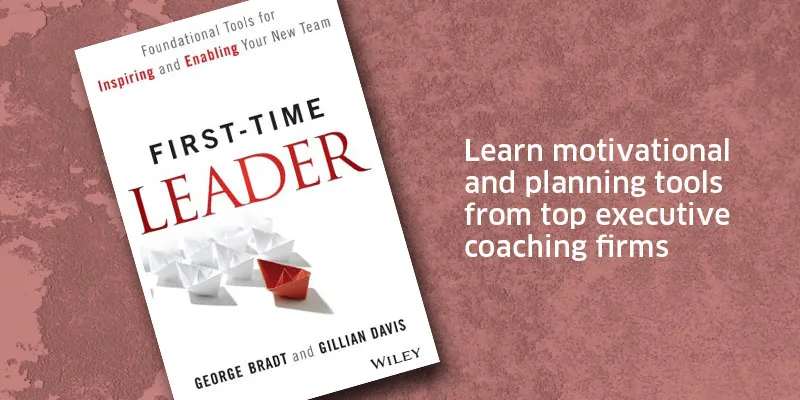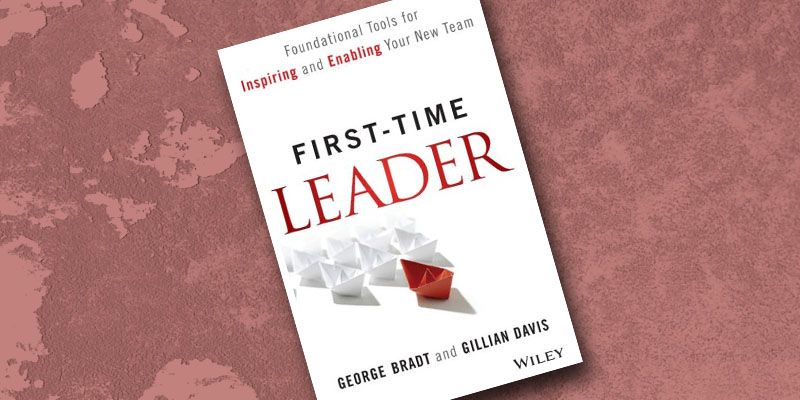First-Time Leader: how startup founders can inspire and enable their new team
Starting up is more than a company creating a new product – it is a new leader creating a winning team. While much attention focuses on how startups should adopt lean approaches to product design, new insights are provided by authors George Bradt and Gillian Davis on leadership and culture.

“Most people become good leaders only after stumbling through new situations, making mistakes and learning from them,” the authors begin. Becoming a leader for the first time is a critical career-defining and indeed life-defining moment, as startup founders are discovering.But leading is different from managing. “Where managing is about organising, coordinating and telling, leading is about inspiring, enabling and co-creating,” the authors explain in their new book, First-Time Leader: Foundational Tools for Inspiring and Enabling Your New Team. See also my review of Startup CEO: A Field Guide to Scaling Up Your Business and my interview with the author Matt Blumberg.
First-Time Leader is packed with useful acronyms as well as 48 tools in the form of worksheets and tables. The tools are also available online (www.OnBoardingTools.com) and are geared towards a range of organisational roles: startup founders, SME heads, internally promoted leaders, leaders appointed from outside, leaders after M&A, VPs, and so on.
The authors base their book on a leadership framework they describe as BRAVE: behaviours, relationships, attitude, values and environment. Leaders need to have a correct assessment of the business environment; values aligned with mission and vision; attitude and culture which sustains the momentum; relationships and communication which help to delegate and inspire; and behaviours which deliver the goals.
Happiness comes from doing things which are good for others and for you, and in which you are good at. Great leadership thus flows from a cause, for the larger rewards despite stress and tough choices.
Leading small teams (less than 10)
When your team is small, the key focus should be on problem solving, locking in core organisational values and creating momentum. New individuals should be roped in based on like-mindedness but with complementary strengths, eg. Wozniak-Jobs in the early days of Apple, Wells-Eisner in Disney, Ernest-Julio in Gallo wines.
The team should focus on experimentation and early sales: learning together, fast, quick, cheap and productively. Challenges include overcoming the ‘trough of despair’ in the face of early failures, and getting past ‘death by a thousand cuts.’
Communication is free and open and the leader knows everyone well – but some clear lines should be drawn. Questions for leaders to resolve include when exactly the product is ripe for generating revenues (eg. ads on Twitter) and when to raise funds (before/after generating revenue, depending on capital expenditure).
Leading teams of 10 to 30
At this stage, the leader can still treat the team like extended family and know everyone, but culture should be preserved while new operating practices and formal performance reviews are implemented.
For example, Rick Rudman, founder of cloud startup Vocus, said the company’s culture was not formally planned in the beginning, but emerged and was then solidified so that newly acquired companies could fit into the culture. Vocus’ culture was defined as work hard and play hard, with a fun and creative workplace (formal meetings took place in the ‘bored’ room, not the board room!). Yoga classes are organised by the It’s All About You committee, and community volunteering is organised by the It’s Not All About You committee.
Corporate culture is the only truly sustainable competitive advantage, but it is rarely the first advantage of a startup. Still, culture preservation should become a top priority for a startup founder, especially as it eyes scale and growth down the road. “Why does everyone want to work for Google? Because they have done an amazing job of marketing their culture outward,” the authors explain.
Leading teams of more than 30
“Once teams grow beyond 30 people or so, you need to get over your natural abhorrence of hierarchy and start substituting some organisational and operating processes,” the authors advise. “You need to drive the vision and values over and over and over again. You will get bored and tired of it way before it begins to get any traction with the newer members of your team,” they warn.
Some leaders keep blogs to share their vision and chronicle their journeys in a more personal way. At the initial stages it helps to show that the leader is decisive but also willing to listen to new viewpoints.
Leaders should be able to identify key internal and external stakeholders, and even past stakeholders. It is important to understand the history of the organisation’s leaders, for reasons of cultural continuity, pivoting or preservation. This often happens when investors or the board of directors appoints a new CEO for a growth-stage startup. “Understand as much as you can about the spark that created the organisation, the founders, and the early starter team – how it developed, its stories and myths. They are all real,” the authors advise.
Leaders need to address all three kinds of risk when they take on the top position – personal risk (eg. culture fit), role risk (eg. responsibilities) and organisational risk (eg. competitors, partners, customers). Newly appointed leaders must get the timing right: when to depart from converging (becoming part of the team) to evolving (initiating new change). Accelerated or delayed timing ultimately comes down to a mix of art and science.
For example, Val Rahmani moved from an IBM role to CEO of cyber-security startup Damballa. She had to learn to deal with fewer resources and less structure, but also appreciated the more nimble and fun structure.
Leaders need to continually scan and intervene in the environment for changes in the core “5 Cs” – conditions, competitors, collaborators, customers, capabilities. This SWOT analysis should also extend to influencers within the segment, and new players in adjacent segments.
For example, KnowledgeTree started off as a systems integrator, but CEO Daniel Chalef then moved into document management based on a reading of the market needs, and pivoted again into the cloud model to tackle higher order problems for their customers. The company was founded in South Africa, but Chalef moved to North Carolina as a base which was not too far away in terms of time zones, and also in a warmer weather zone which his African colleagues preferred.
Timothy Patrick started off in the field of clinical needs for cancer patients – he learnt from the example of brain cancer and launched the company Proxima in breast cancer. He then sensed a new need in the ageing US population and launched another startup, Carticept, for steroid injections. Patrick is a good example of a leader who can both ‘sprint and run the marathon.’
Leaders should also know where their company should not play, as important as knowing where to play. Omar Hussain, CEO of healthcare IT security firm Imprivata, decided to focus on value and not just full-spectrum services; he re-focused the company on secure single sign-on solutions when the industry was transforming from paper to digital records.
Business leaders should therefore develop a good sense of trends and scenarios in industry emergence, expansion, stagnation and consolidation. For example, Richard Branson enters markets where the incumbent leaders are not doing a good job, so that they can be disrupted with better quality services. Leaders define the company’s industry positioning, eg. proactive (Apple), fast follower (Coca-Cola), prepared (Red Cross), responsive (Ritz).
“Relationships are the heart of leadership. If you can’t connect, you can’t lead,” the authors caution. Vision is your picture of success. Values are principles on which you will not compromise. Attitude is the central link in the BRAVE framework.
Communication is at the core of relationships, and leaders should have a clear MAP – message, amplifiers/influencers and perseverance. Leadership communication is about both influence and inspiration. Unfortunately, many leaders get stuck in their inability to effectively manage activities such as meetings. Focus on pre-work and follow-through can help in this regard.
Leaders need to effectively develop their next level of leadership and talent though the ADEPT framework: acquire, identify, develop, encourage, plan, transition. The authors provide a useful table of 20 skills and attitudes that leaders need to check for when they hire new talent, eg. there should ideally be a good skill-culture match, but limits of acceptability for tradeoffs.
Ramping up of new employees should be facilitated via accommodation, assimilation and acceleration. They need to be given the right resources and contacts to succeed, and motivated via new challenges, responsibilities and recognition. Goals set for the teams and organisations should be SMART: specific, measurable, actionable/attainable, relevant and time-bound.
Leaders should also master the change management ABC: antecedents, behaviours, consequences. “Transformational change requires aligning plans, people and practices around a shared purpose,” the authors advise. Ultimately, a leader needs to know how to turn individual strengths into winning team synergies, across different personality types: creative, technical, detail oriented and operational.
One of the challenges for leaders, especially in startups at scale stage, is going beyond micro-management. Overworking is deconstructive, unhealthy and unsustainable.
Leaders should know the basics of delegating tasks along the continuum: do well yourself; do yourself but just well enough; delegate and supervise; delegate and ignore; do later; and do never. Employee interest should be gauged along the AIDA scale: aware, interested, desirous, action-oriented.
Without over-planning, leaders should also design and celebrate appropriate milestones: setting them as targets, but with room for flexibility, learning and response. Another hallmark of leadership is response during times of crisis and disaster. Think of the physical, political, emotional, reputational and financial risk – in that order, the authors advise.
The book also includes some useful quotes, and it would be good to end this review with a handful of these:
“Do not confuse motion and progress. A rocking horse keeps moving but does not make any progress.” – Alfred Montapert
“It is better to be vaguely right than precisely wrong.” – Leonard Lodish
“Don’t mistake activity with excitement.” – John Wooden
“In theory, there is no difference between theory and practice. But in practice, there is.” – Jan Snepscheut
Author profiles:
George Bradt is managing director of PrimeGenesis, and author of the books The New Job 100-Day Plan and Onboarding. He was previously at Unilever, P&G, Coca-Cola. Gillian Davis is a London-based leadership coach.










![[Exclusive] Vauld to seek 3-month moratorium extension as creditors panel explores bailout options](https://images.yourstory.com/cs/2/a09f22505c6411ea9c48a10bad99c62f/VauldStoryCover-01-1667408888809.jpg)
